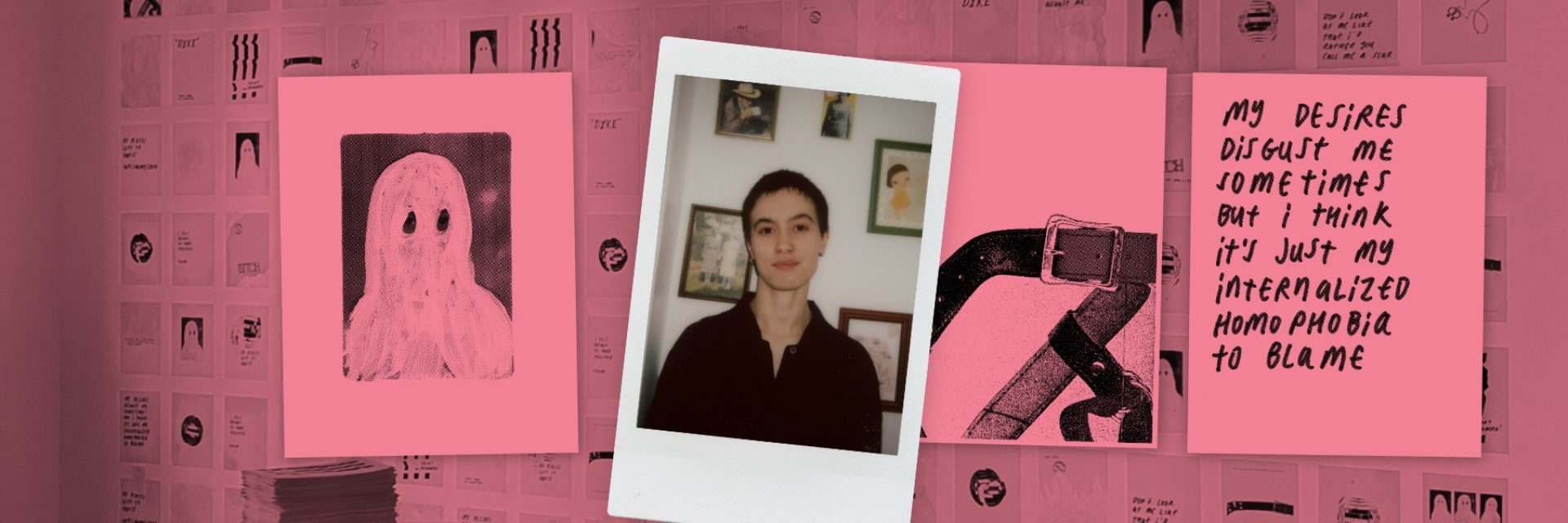Beauty From Pain

Printmaker Eli Nolet’s sensitive, sometimes defiant work has an understated maturity born out of queer trauma.

Among the many works of local art I’ve bought, traded for, and been gifted over the years is a small intaglio print by Eli Nolet. A sharply-lined etching of a dead sparrow on its back bears a broken heart-shape on its chest that bursts with delicate pink foliage and intricately textured bursts of red. With Childhood One as its title, this is a quietly painful work that, despite its literal bloodshed, is guarded by beauty.
Printmaking is an inherently slow and methodical way to make a work of art, a process well suited to Nolet’s tendency to take things slow. They emphasize the importance of being gentle on oneself, especially when making art rooted in the trauma and pain of negotiating queer identity. This refreshing resistance to the high-pressure hustle culture of their age feels prescient at a time when such expectations are buckling under the weight of a global pandemic.

Nolet’s artistic aptitudes were uniquely nurtured by Hamilton’s cultural landscape. As a student at Westdale, they participated in Centre[3]’s NuSteel educational program, which provided hands-on instruction in printmaking and early practise in probing the meaning behind one’s creations. Nolet went to work at Centre[3] after high school, gaining all the early experience that entails: delivering community art programs and participating in monthly Art Crawls while learning to price and sell their work. The understated maturity that Nolet bears as a young artist who lived a working artist’s practice before stepping foot in an undergraduate art program is evident in the nuance and sensitivities found in their work.
Even so, Nolet felt the push to pursue further studies “in the big city” – in their case, Toronto and OCAD University. While excited to see openly queer people thriving at OCAD during campus visits, the notion of living alone in a strange place was not enticing. Nolet recalls an anxious train ride home from visiting a friend living on campus in Ottawa, on the same day they were scheduled to interview Catherine Gibbon for the Hamilton Arts Council’s Building Cultural Legacies project: a conversation that proved to be a revelation.

Gibbon – an accomplished and beloved painter whose recent death has been deeply felt across Hamilton’s art community – was living proof of an artist who made work she was passionate about and kept a studio she loved in Hamilton for the whole of her creative career. Nolet met a friend in a coffee shop after the interview with Gibbon, and in their words, “broke down. I realized I didn’t want to leave Hamilton.” Nolet chose McMaster’s Studio Art program instead, a setting that appealed with its small class sizes and environmentally sustainable studio practices.
The pandemic has since stripped away the advantages of classes and studios, accelerating the challenge of making art outside the shelter of art school. Working with the scant amount of floor space available in their student housing was a “continuously frustrating” battle for space that involved a lot of crouching and claustrophobia before they chose to move back home to the North End. Nolet’s creative concerns – their incisive exploration of queer bodies in social spaces – are matters for the public realm. This is work that needs space to breathe.
Public Gesture, a work on view late last year at downtown’s Hamilton Artists Inc., wallpapered a portion of the gallery with a repeating grid of 18 distinct prints, with a stack of copies available for the viewer to take at will. These deeply personal neon-pink posters internalize the doubts sown by a homophobic environment, while defiantly asserting desire in the face of hate. The vulnerability of claiming these startling slurs is deepened by Nolet’s choice to make the posters freely available to visiting strangers. Whether a print is treasured and framed later, violently defaced and discarded, or simply crushed and forgotten in a bag, is left to chance. It has “a physical existence that’s beyond me.”

This exhibition at the Inc. provided an increasingly precious opportunity for Nolet to connect with fellow artists and swap anecdotes of the city’s queer history, a cultural facet that is notoriously under-documented in Hamilton. Their ongoing quest for this local lore is reflected in a growing interest in the material of queer culture, from disco balls to intricate chainmail jewellery. More recent experiments in video and sound have featured mirrorball light bouncing off spandex draperies that sparkle with the promise of the dancefloor but hold a haunting absence.
These meditative videos ache with nostalgia for dance clubs now closed, and the anxiety that curdles a hopeful return to these spaces. As Nolet reveals, public spaces have always been sites of uneasy welcome for queer people in particular – but in this claiming and naming, there is defiant demand for joy, too.
“For more information, visit www.elinolet.com






